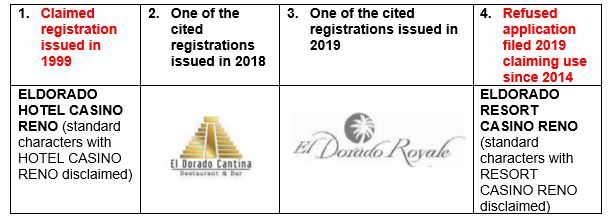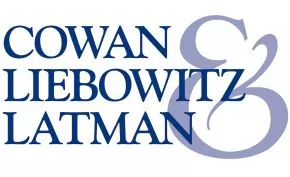Can your application to register an updated version of your previously registered mark be accepted despite a third party's coexisting similar registered mark? Two decisions of the Trademark Trial and Appeal Board (TTAB) say "perhaps."
1. In re Hana Financial Group Inc., Application No. 86019890 (T.T.A.B. June 2, 2021).
The applicant's (subsidiary's) prior registrations postdated the cited registration, but one of the prior registrations and the cited registration had coexisted for more than five years.

Hana Financial Group Inc. (Hana) filed an intent to use application in 2013 to register HANA BANCORP & Design for advertising, insurance, financial and real estate services. The examining attorney refused registration citing a previously existing 1996 registration of HANA FINANCIAL & Design for financial services owned by Hana Commercial Finance, Inc.
This would have seemed unremarkable except that, despite the then-existing 1996 cited registration, a wholly-owned subsidiary of Hana had been issued registrations in 2015 and 2018 of HANA BANK & Design and HANA GROUP & Design, for the same services as were listed in Hana's 2013 application. The cited registration and one of the claimed registrations of Hana's subsidiary had coexisted for more than five years, and both of them had been registered for more than five years, which meant that they could not be cancelled for a likelihood of confusion.
The Trademark Trial and Appeal Board (TTAB) ruled that, since the HANA BANK and HANA GROUP registrations were owned by Hana's wholly-owned subsidiary, Hana could rely on them for purposes of asserting that there was no likelihood of confusion between its applied- for mark HANA BANCORP and the cited registration HANA FINANCIAL. The TTAB then reversed the examining attorney's refusal of registration.
In assessing a likelihood of confusion, the TTAB normally considers thirteen factors enunciated in the seminal case In re E.I. du Pont de Nemours & Co., 476 F,2d 1357 (C.C.P.A. 1973). But in the Hana Financial case, the TTAB focused solely on the rarely invoked thirteenth Du Pont catch-all factor: "any other established fact probative of the effect of use."
In doing so, the TTAB applied the considerations discussed
in In re Strategic Partners, Inc., 102 USPQ2d
1397 (T.T.A.B. 2012) (which had relied on the thirteenth DuPont
factor finding that the "unusual situation" of the
coexistence of applicant's prior registration of the mark
ANYWEARS with third-party cited mark  for more than five years made confusion
between the applicant's mark
for more than five years made confusion
between the applicant's mark ![]() and the cited mark unlikely).
and the cited mark unlikely).
In the current case, the TTAB said:
- There is no "meaningful difference" between the marks in the prior registration of Hana's subsidiary and the present application;
- The services are at least in-part identical; and
- One of the prior registrations of Hana's subsidiary and the cited registration both are more than five years old and thus immune from attack on likelihood of confusion grounds.
The TTAB found that all three of the Strategic Partners requirements had been met, and that the thirteenth DuPont factor overcame the other DuPont factors that otherwise might have supported a finding of a likelihood of confusion.
2. In re Eldorado Resorts LLC, Application No. 88514634 (T.T.A.B. July 8, 2021).
The applicant's prior registration predated the cited registrations by about 20 years but the respective registrations had coexisted for less than five years.

Eldorado Resorts LLC (Eldorado) filed an application in 2019 to register ELDORADO RESORT CASINO RENO claiming use since 2014 for hotel and restaurant services. The examining attorney refused registration citing six previously existing registrations, which included a 2018 registration for EL DORADO CANTINA & Design for restaurant services owned by El Dorado Cantina 55, LLC, and a 2019 registration for EL DORADO ROYALE & Design for hotel services owned by Fantastic Brands, LLC.
Eldorado owned a 1999 registration of ELDORADO HOTEL CASINO RENO for hotel and restaurant services. The cited 2018 and 2019 registrations had been issued despite Eldorado's preexisting 1999 registration. But in this case, the claimed registration and cited registrations had only coexisted for less than five years although the claimed 1999 registration had been registered for more than five years.
The Examining Attorney argued that the coexistence of the respective registrations for less than five years made Strategic Partners inapplicable. Eldorado argued that, regardless of the dates of registration, the respective parties' marks had coexisted by use in the marketplace for more than five years. The TTAB said that the duration of marketplace coexistence was not dispositive, and that this factor should be considered together with all other relevant factors.
Nevertheless, the TTAB reversed the examining attorney's refusal of registration. The TTAB gave weight to the fact that no likelihood of confusion had been found by the examining attorneys in six separate situations, although it acknowledged that it was not bound by those decisions. The TTAB noted that in any likelihood of confusion analysis, the key considerations are the first two DuPont factors--the similarities of the marks and the relatedness of the goods and services—and here both factors supported a finding of likelihood of confusion. But the TTAB held the thirteenth DuPont factor was pivotal, and that the preexisting registration owned by Eldorado outweighed those two key factors.
Author's Note: Even if you have registered your mark, these decisions should encourage you to arrange for a trademark watching service that will alert you when anyone else applies to register a confusingly similar mark. You should consider opposing such an application if it is published for opposition.
If you choose not to oppose that application and that mark matures to a registration, you cannot safely let both marks coexist on the register because you cannot seek to cancel a registration on the ground of likelihood of confusion after that registration has existed for five years, and you may not be successful in opposing an application by the third party to register another version of its registered mark for at least some of the same goods or services.
The content of this article is intended to provide a general guide to the subject matter. Specialist advice should be sought about your specific circumstances.

